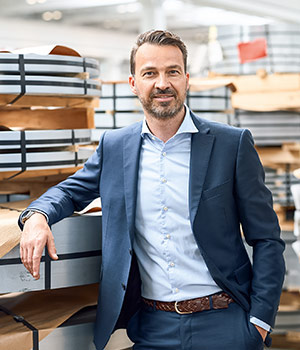Text Markus Huneke ––– Photography
Mr. Sonst, green steel is definitely on the way, but what does that actually mean for the market – your customers, for example?
As far as the material itself is concerned, nothing! In terms of technology, there is no difference between green steel grades and conventional steel. There is no need for companies processing fossil- free steel to modify their production processes or invest in new equipment. Steel processors do, however, face a different challenge – can they be sure the green steel they purchase really is from fossil-free production? Proof of a green footprint will be vital in supply chains in the future, whether to comply with potential regulations or when communicating with customers, for whom the use of green steel is becoming increasingly important.
The first real volumes of fossil-free steel are set to be available from around 2025. When will this issue be relevant for your customers in practice?
It already is! Our customers have been contacting us for some time now, hungry for information about green steel. They are asking what “green” really means for steel products as such, what emissions are actually involved, and whether there are differences between various products and manufacturers. This tells us that there is great uncertainty in the market regarding the workflows and processes involved in producing fossil-free steel. I am therefore convinced that a new, dedicated ecosystem will be created for these steels. Being an independent steel service centre puts us in an excellent position to provide impetus for a neutral information network of this kind.
Stahlo showcased a blockchain application for carbon tracking at Euroblech. Won’t converting the entire steel supply chain to technology of this kind be a huge undertaking?
Not at all! A blockchain application requires neither big investments nor a largescale conversion of existing processes. Essentially, it’s simply a case of passing on a blockchain data set. A specific data set is assigned to each steel product, and information about the respective emissions generated is added at each stage of production. Standard IT technology can be used to manage blockchain data sets. Quality and production data is already being passed on. In most cases, however, this is on an analogue basis and susceptible to potential tampering.
You support the creation of an ecosystem for steel. Why is that?
Databases are a possible alternative, but the idea of an ecosystem is very appealing. The data then belongs to a community – the members of the network – which prevents it from being used unilaterally. A community is likely to be more trusted than the database of a closed group, for example, so this could be a key factor in the willingness to pay extra for green products. That would be very important for the necessary investments.
